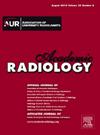Diffusion Tensor Imaging and Evaluation of Cardiac Ischemic Disorders: A Systematic Review
IF 3.8
2区 医学
Q1 RADIOLOGY, NUCLEAR MEDICINE & MEDICAL IMAGING
引用次数: 0
Abstract
Background
A suitable diagnostic method can be beneficial owing to the high prevalence of myocardial infarction (MI) and structural changes that affect systolic and diastolic performance. In this systematic review, we focused on the possibility of using DTI instead of current methods such as cardiac biopsy, an invasive procedure.
Methods
Articles published in PubMed, Scopus, Embase, and Scholar electronic databases from 2010 to 2023 were reviewed using the determined keywords. The articles included evaluating DTI in patients with MI, compared to standard myocardial structure. Studies that did not examine the association between DTI and cardiac ischemic disorders only considered original articles. Methodological risk was evaluated using QUADAS-2 tool.
Results
Sixteen articles were selected from 16855 searched articles and divided into two subgroups: human-based (six studies) and animal-based (ten studies). Among the results obtained from both animal and human-based evaluations: (a) the values of the FA, RD (λ⊥), and AD (λ∥) indices in the infarcted region were lower than those in the remote or adjacent areas, and the value of the MD index increased. (b) This trend was also present in both acute and chronic conditions and in the follow-up of patients for the assessment of microstructure remodeling. (c) Confirming the process of change evaluated in preclinical human studies. More studies should be conducted on the effects of factors such as the B-value index and environmental conditions.
Conclusion
Clarifying the trend of changes in DTI indices for AMI and CMI makes them suitable diagnostic tools in this regard. Meanwhile, the study faced limitations such as low sample size and the risk of bias about “patient selection” index.
弥散张量成像和评价心脏缺血性疾病:系统综述。
背景:由于心肌梗死(MI)的高患病率和影响收缩和舒张表现的结构改变,合适的诊断方法可能是有益的。在这篇系统综述中,我们关注的是使用DTI代替目前的方法,如心脏活检,一种侵入性手术的可能性。方法:使用确定的关键词对2010 - 2023年在PubMed、Scopus、Embase和Scholar电子数据库中发表的文章进行检索。这些文章包括评价心肌梗死患者的DTI,并与标准心肌结构进行比较。没有研究DTI和心脏缺血性疾病之间关系的研究只考虑了原创文章。采用QUADAS-2工具评估方法学风险。结果:从16855篇检索文章中选择了16篇文章,并分为两个亚组:人类研究(6篇)和动物研究(10篇)。在基于动物和人类的评估结果中:(a)梗死区域的FA、RD (λ⊥)和AD (λ∥)指数的值低于远端或邻近区域,而MD指数的值增加。(b)这一趋势也存在于急性和慢性疾病以及对患者进行微观结构重塑评估的随访中。(c)确认临床前人体研究中评估的变化过程。b值指数、环境条件等因素的影响有待进一步研究。结论:明确AMI和CMI的DTI指标变化趋势,使其成为AMI和CMI的合适诊断工具。同时,本研究还存在样本量小、“患者选择”指标存在偏倚风险等局限性。
本文章由计算机程序翻译,如有差异,请以英文原文为准。
求助全文
约1分钟内获得全文
求助全文
来源期刊

Academic Radiology
医学-核医学
CiteScore
7.60
自引率
10.40%
发文量
432
审稿时长
18 days
期刊介绍:
Academic Radiology publishes original reports of clinical and laboratory investigations in diagnostic imaging, the diagnostic use of radioactive isotopes, computed tomography, positron emission tomography, magnetic resonance imaging, ultrasound, digital subtraction angiography, image-guided interventions and related techniques. It also includes brief technical reports describing original observations, techniques, and instrumental developments; state-of-the-art reports on clinical issues, new technology and other topics of current medical importance; meta-analyses; scientific studies and opinions on radiologic education; and letters to the Editor.
 求助内容:
求助内容: 应助结果提醒方式:
应助结果提醒方式:


